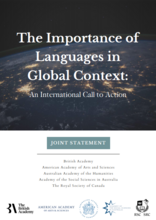
Research shows that multilingual skills correlate with higher scores on assessments (Vogel and Garcia, 2017), and studies indicate that when those results are present, there has been a conscious and systematic use of diverse linguistic resources which has become part of the curriculum and pedagogical strategies (Madiba, 2013; Garcia, 2009).
Most English learner (EL) programs at institutes of higher education teach the mechanics of English itself (Valdes, 2020), so they are geared toward multilingual students who usually have already mastered conversational English. What students need is a continuous and systematic pedagogical approach that enhances the acquisition of academic English along with the cognitive skills that they already bring to the classroom.
Vogel and Garcia (2017) explain translanguaging thus: ”rather than possessing two or more autonomous languages systems, as has been traditionally thought, bilinguals, multilinguals, and indeed, all users of language, select and deploy particular features from a unitary linguistic repertoire to make meaning and to negotiate particular communicative contexts.” For example, bilingual students use both their languages to “adapt their language practices to the particular communicative situation in which they find themselves in order to optimize communication and understanding” (Hesson, Seltzer, and Woodley, 2014). Such linguistic repertoire includes not only words, sounds, usage, or syntactic rules but also the social features associated with multimodal communication (e.g., gestures, visuals, signs, etc.). So, translanguaging design builds pedagogical strategies upon this entire set of resources (Garcia, Johnson, and Seltzer, 2017). It strategically builds pedagogical principles based on language, lived experiences, and cultural references that are part of the different modes of communication available to multilingual students in any particular situation.
Most U.S. higher education institutions are greatly influenced by monolingual ideologies and have been hesitant to fully implement multilingual practices in the curriculum. However, some institutions have allowed flexibility in the curriculum, so students and professors have engaged in better teacher–student relations that encourage them all to take risks in challenging dominant language discourses that devalue home languages. Research studies demonstrate that when higher education institutions allow the use of translanguaging pedagogy, students’ desire to learn increases with tangible results in terms of academic performance (Carrol and Mazak, 2017). Translanguaging pedagogy creates spaces where university bilingual students maximize their potential as accomplished learners.
Translanguaging refers to multiple language practices which individuals use to make sense of their multilingual worlds (Rivera and Mazak, 2017). Students translate, code switch, and translanguage to make sense of academic courses. These particular linguistic practices open new perspectives to understand the use of home languages as educational resources that enrich the learning experience of emergent bilingual students in higher education. Multilingual students bring into the classroom different ways to interact through language use, and they enhance their educational possibilities by breaking rules of traditional monolingual language practices.
Garcia (2009) suggests that bilingual students translanguage by using linguistic tools, knowledge, and features from the languages they know. This means that multilinguals go beyond linguistic borders and blend their languages to fulfill their communicative needs. Translanguaging does not see the possession of two or more languages as separate or autonomous. Rather, translanguaging see the acquisition of languages as a formation of a single linguistic system stored in the mind where bilingual speakers have the autonomous decision-making role of selecting and using language according to their communicative needs.
The dominant monolingual educational space does not promote the use of bilingual students’ language knowledge and cognitive skills. Such restriction denies the additional resources that languages other than English can offer to access and navigate in the system. In contrast, translanguaging practices stress the language-as-resource perspective. This is a recursive pedagogy that can create new educational possibilities in higher education.
In most U.S. universities today, academic language proficiency is measured by standardized testing with an English-only ideology. An educational environment that promotes linguistic diversity enables multilingual students to succeed by maximizing their full potential. Translanguaging is a well-designed use of students’ native linguistic practices to enhance understanding of academic content in English. The key idea is seeing languages other than English as educational tools that enhance the acquisition of academic content and the target language.
Although English is the most common medium of instruction in the U.S., the reality is that multilingual students in higher education navigate in academia using their languages to make sense of the school experience (Garcia, Johnson, and Seltzer, 2017). They may use different linguistic resources to tackle academic tasks such as test preparation and written or oral assignments to express their understanding of content. Translanguaging offers a new pedagogical design for multilingual students in the acquisition of knowledge, reaffirmation of their identities, and full multilingualism.
In some universities, professors are allowed to incorporate students’ native languages in teaching. Professors can use this flexibility to include translanguaging practices to provide a scaffolding approach for effective learning in science and engineering programs (Rivera and Mazak, 2017). This effective curriculum flexibility allows the use of different linguistic resources (e.g., code-switching, translation, etc.) in some assignments or tests so students can demonstrate mastery of content previously taught in English.
In one example at a Chinese university, a math professor (who spoke Mandarin only) used diverse semiotic resources to set up a translanguaging space with students who spoke Mandarin, Cantonese, Putonghua, and English by allowing the use of PowerPoint slides, math symbols, blackboards, layouts, pictures, graphic organizers, and gestures in every language to facilitate the understanding of math content (He, Lai, and Lin, 2017). Some of these resources were fully or partially displayed in different languages. It was a collaborative work where all participants engaged in co-constructing the learning experience. Mathematics is a semiotic means of communication on its own. As the authors of the study explain, math meaning-making processes are tied to symbolism (e.g., formulas, equations, etc.), visual displays (e.g., tables, graphs, etc.), and verbal/written language (e.g., textbooks and verbal explanations) (He, Lai, and Lin, 2017).
So, translanguaging pedagogy fits perfectly with teaching math to emergent multilingual students because the class turned into a space where the meaning-making process of math content was scaffolded by the addition of the students’ linguistic repertoires and multimodal resources. The tangible results were manifested by an increased desire for learning and engagement. Additionally, the dynamic of the class was changed from “teacher as deliverer” to a teacher/student co-teaching and co-learning environment.
University faculty can start implementing translanguaging in the following ways:
- Helping multilingual students to recognize their linguistic potential
- Allowing students to engage in co-creating knowledge with them
- Using all available language resources (e.g., bilingual dictionaries, textbooks, online translators)
- Experimenting with different translanguaging strategies (e.g., code-switching, translation, multimodality)
It is important to note that faculty at institutions of higher education might not be able to fully implement translanguaging pedagogy. However, when designing their lesson plans, they may find opportunities for the incorporation of translanguaging strategies appropriate for their multilingual students. Similar studies in higher education have found a direct correlation between translanguaging pedagogy and higher levels of learning and more sense of belonging, which are crucial ingredients to increase the motivation to succeed (Karlsson, Larsson, and Jakobsson, 2018; Klapwijk and Walt, 2016). The strategic use of students’ linguistic repertoires turns into a powerful resource that assists them in developing understanding of scientific knowledge and at the same time increases the likelihood of their staying motivated until the completion of their studies.
When professors allow the use of these tools and incorporate them in their daily activities, they create a translanguaging space that will transform the learning and teaching experience. The transformation will lead students to become aware of the importance of their own cultures, languages, and lived experiences. Their identities will be reaffirmed and levels of engagement will increase.
As educators, we need to encourage students to acknowledge and develop their linguistic repertoires by being aware of their potential to improve the learning experience. Using tools requires acknowledging their existence; then the strategic use will follow. Although bilingual students and professors may naturally use translanguaging, they need to be aware of its value and learn to use it effectively in their learning and teaching.
A good starting point for institutions of higher education to implement translanguaging is by inviting their faculty to learn about translanguaging and implementing a modified curriculum with translanguaging strategies, especially when they have a multilingual student population. Designing a translanguaging classroom involves the construction of a collaborative “space by the teacher and bilingual students as they use their different language practices to teach and learn in deeply creative and critical ways” (Garcia, Johnson, and Seltzer, 2017). Creating spaces to bring together faculty, administrators, and other stakeholders to discuss new ways of increasing academic achievement among multilingual students is the next step.
When multilingual students are discouraged from using their home languages, they are deprived of practices and tools that enhance their capacity for making sense of content and their experiences. These pedagogical practices take their toll on the academic performance of multilingual students. When emergent multilingual students are assessed, their full linguistic repertoires are not part of the assessment (Garcia, 2009), so their full potential remains unknown. An educational space that promotes linguistic diversity creates a unique environment to abandon the monolingual approach of education and take advantage of different linguistic resources to enhance understanding. Most professors do not have training in multicultural and multilingual education. Therefore, the academic achievement of minority students is heavily influenced by these dominant values and beliefs reflected in the teachers’ pedagogical practices and their perceptions about the students’ potential. The current research about translanguaging pedagogy in higher education shows that it can certainly be an effective tool to increase graduation rates among emergent multilingual students. Institutions of higher education can take the lead in creating and promoting a translanguaging space where it becomes an educational resource. Translanguaging pedagogy keeps students motivated during their university careers because they see the connection with their own future academic goals, lived experiences, families, cultures, and communities.
Translanguaging design goes beyond scaffolding because it creates spaces that motivate emergent bilingual students to acquire knowledge—not just vocabulary and grammar—but also to reaffirm their identities and sense of cultural belonging. The use of their entire linguistic repertoires maximizes their full potential because it encourages them to take risks. Their awareness of being emergent multilingual students does not make them feel at a disadvantage but rather gives them courage to explore new educational possibilities in academia. Translanguaging is a promising approach that needs to be explored to discover its possibilities. Institutions of higher education can move translanguaging principles up to the level of policy making by inviting willing professors to experiment with these innovative pedagogical principles.
References
Carrol, K., and Mazak, C. (2017). “Language Policy in Puerto Rico’s Higher Education: Opening the door for translanguaging practices.” Anthropology & Education Quarterly, 48(1).
Garcia, O., Johnson, S., and Seltzer, K. (2017). The Translanguaging Classroom: Leveraging Student Bilingualism for Learning. Philadelphia, PA: Caslon.
Garcia, O. (2009). “Bilingualism and Translanguaging.” Bilingual Education in the
21st Century: A Global Perspective. Malden, MA: Willey-Blackwell.
He, P., Lai, H., and Lin, A. (2017). “Translanguaging in a Multimodal Mathematics Presentation.” In C. Mazak and K. Carrol (eds.), Translanguaging in Higher Education: Beyond Monolingual Ideologies, 91–120. Bristol: Multilingual Matters.
Hesson, S., Seltzer, K., and Woodley, H. (2014). Translanguaging in Curriculum and Instruction: A CUNY-NYSIEB Guide for Educators. www.cuny-nysieb.org/wp-content/uploads/2016/04/Translanguaging-Guide-Curr-Inst-Final-December-2014.pdf
Karlsson, A., Larsson, P., and Jakobsson, A. (2018). “Multilingual Students’ Use of Translanguaging in Science Classrooms.” International Journal of Science Education, 1–21.
Klapwijk, N., and Van der Walt, C. (2016). “English-Plus Multicultural as the New Linguistic Capital? Implications of university students’ attitudes towards languages of instruction in a multilingual environment.” Journal of Language, Identity, and Education, 15(2), 67–82.
Madiba, M. (2013). “Multilingual Education in South African Universities: Policies, pedagogies, and practicality.” Linguistics and Education, 24, 385–395.
Rivera, A., and Mazak, C. (2017). “Pedagogical Translanguaging in a Puerto Rican University Classroom: An exploratory case study of student beliefs and practices.” Journal of Hispanic Higher Education, 1–15. doi.org/10.1177/1538192717734288
Valdes, G. (2020). “Sandwiching, Polylanguaging, Translanguaging, and Codeswitching: Challenging monolingual dogma in institutionalized language teaching.” In J. McSwain and F. Christian (eds.), Codeswitching in the Classroom: Critical Perspectives on Teaching, Learning, Policy, and Ideology. New York, NY: Routledge.
Vogel, S., and Garcia, O. (2017). “Translanguaging.” In G. Noblit and L. Moll (eds.), Oxford Research Encyclopedia of Education. Oxford: Oxford University Press.
Samir Monges is a doctoral student at the University of Utah. His research interests are located in the intersection among language, philosophy, and education. He is currently working on his doctoral dissertation, which focuses on translanguaging in higher education.














